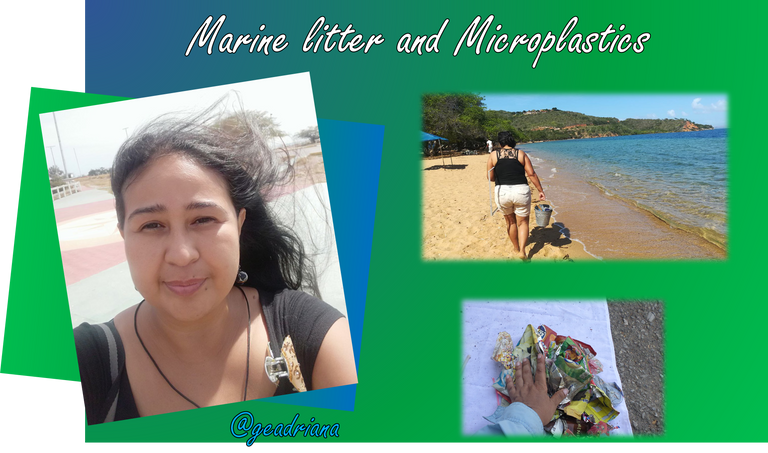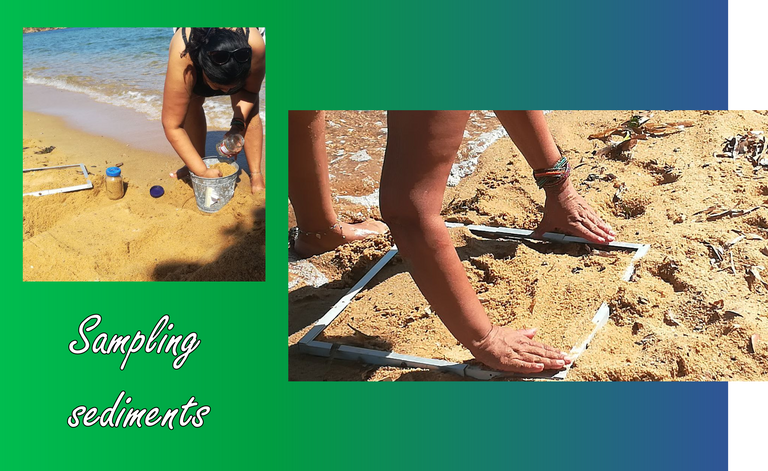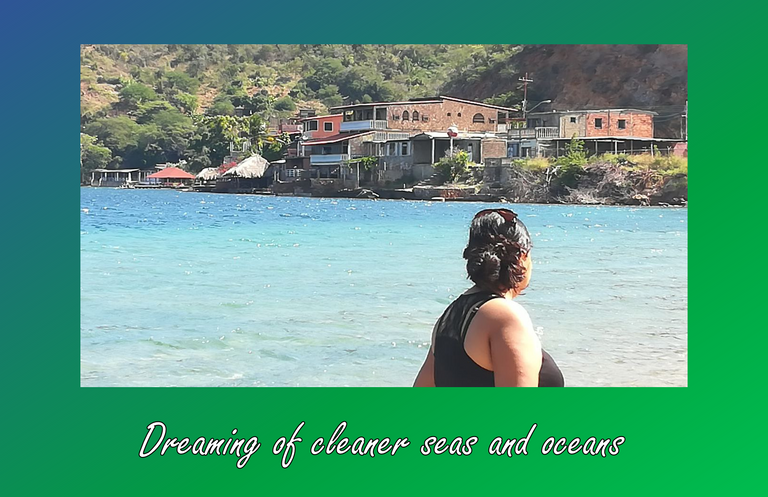Contrario a lo que alguna vez se popularizó o quizás se mal entendió, los materiales plásticos no son biodegradables en las condiciones naturales, y mucho menos si se considera el volumen y la diversidad de materiales que ingresan al medio marino. Luego de entrar en el ambiente y degradarse, los materiales plásticos pueden alcanzar dimensiones tan pequeñas que no son apreciables por el ojo humano, pasando desapercibidas y entrando en contacto directo con los diferentes organismos marinos e incluso con nosotros, ya que permanecen indefinidamente en los diferentes medios por ejemplo en los cuerpos de agua y en el aire.

Para lograr su detección se deben emplear ciertas metodologías y equipos de análisis químicos muy sofisticados y, por ende costosos. Todo esto, aunado a la influencia de otros estresores del medio marino y a su importancia para el sostenimiento de la vida en el planeta, ha generado una fuerte preocupación sobre el estado o calidad ambiental de los diferentes mares y océanos del mundo, la cual ido en aumento hasta el punto que en el 2021 la Organización de las Naciones Unidas proclamó el decenio de las ciencias oceánicas para el desarrollo sostenible para lograr un océano limpio y productivo que apoye el desarrollo sostenible a nivel mundial.
En este caso, no solamente se toma en cuenta la dinámica del océano y sus características para describirlo, conocerlo y comprenderlo y/o definir cuál es su estado, sino también en el establecimiento de un marco de acciones y respuestas para minimizar las fuentes de contaminación, promoviendo entre otras cosas la valoración y el reconocimiento de su importancia para el desarrollo sostenible y el bienestar humano.
Específicamente hablando del plástico, se debe tomar en consideración que ciertamente el plástico han sido empleado para satisfacer ciertas necesidades de los seres humanos, y que gracias a este material se han podido desarrollar varias innovaciones tecnológicas en el área de la salud (por ejemplo, para garantizar las esterilidad de materiales médicos y quirúrgicos, el uso de lentes de corrección) y en las telecomunicaciones contribuyendo en cierta forma a nuestro bienestar. Sin embargo, un consumo excesivo de estos materiales y la falta de conciencia sobre el manejo de los residuos y desechos plásticos han generado una acumulación importante en diferentes entornos.
La basura plástica mal gestionada se transforma microplásticos y nanoplásticos que alcanzan diversos ecosistemas y organismos marinos a lo largo de la trama trófica, los cuales al ser consumidos por los seres humanos podrían afectar su salud.
Cuando se reconoce la presencia de estos materiales en aguas, sedimentos y organismos de forma directa, e incluso se manejan datos confiables sobre su abundancia y distribución se puede tener conciencia de lo que realmente está pasando y reflexionar al respecto. Entonces, el paso siguiente sería hacer los cambios y establecer las acciones para contribuir a dar solución a este problema global.
En este punto, es necesario reconocer que hace falta la realización de investigaciones científicas que caractericen los entornos potencialmente afectados para diseñar planes específicos de intervención. Sim embargo, mientras se busca como llevar a cabo los estudios pertinentes, es necesario promover cambios significativos en los patrones de consumo, sobre todo en los plásticos de un solo uso, establecer alianzas, estrategias políticas y ordenanzas que sean sostenibles en el tiempo y que se enfoquen en la recuperación de los espacios afectados para lograr la conservación y protección los espacios marino-costeros.

Por eso, me he dedicado desde 2018 a estudiar, aprender , tomar muestras de sedimentos de algunas playas del oriente venezolano, a la vez que apoyo a muchos estudiantes que desean realizar trabajos de grado y obtener sus títulos universitarios. Ha sido una labor ardua que me dejó agotada el 2021, porque al no tener financiamiento pues tenía otras implicaciones.
Este año empiezo por poner orden a las cosas, cerrar los pendientes, y buscar la forma más idónea para buscar financiamiento y si no salen por la vía institucional, pues me estoy enfocando para obtenerlos por otros medios.
Yo deseo que toda esa pasión que yo tengo por desarrollar mi investigación y contribuir con la conservación del planeta, sea recibida por el universo y toda esa energía sean canalizada y transformada en la magia que deseo para seguir trabajando con mucho amor, por la ciencia, la educación y la conservación de los mares y océanos.
Ayuda a la Tierra, sé parte del cambio
English Version
Contrary to what was once popularized or perhaps misunderstood, plastic materials are not biodegradable under natural conditions, much less considering the volume and diversity of materials that enter the marine environment. After entering the environment and degrading, plastic materials can reach such small dimensions that they are not appreciated by the human eye, going unnoticed and coming into direct contact with different marine organisms and even with us, since they remain indefinitely in different media for example in bodies of water and in the air.
To achieve its detection, certain methodologies and very sophisticated chemical analysis equipment must be used and, therefore, expensive. All this, together with the influence of other stressors in the marine environment and its importance for sustaining life on the planet, has generated a strong concern about the state or environmental quality of the different seas and oceans of the world, which has been in increase to the point that in 2021 the United Nations Organization proclaimed the decade of ocean science for sustainable development to achieve a clean and productive ocean that supports sustainable development worldwide.
In this case, not only the dynamics of the ocean and its characteristics are taken into account to describe, know and understand it and/or define its state, but also in the establishment of a framework of actions and responses to minimize sources of pollution. , promoting among other things the appreciation and recognition of its importance for sustainable development and human well-being.
Specifically speaking of plastic, it must be taken into consideration that certainly plastic has been used to satisfy certain needs of human beings, and that thanks to this material it has been possible to develop various technological innovations in the health area (for example, to guarantee the sterility of medical and surgical materials, the use of correction lenses) and in telecommunications, contributing in a certain way to our well-being. However, excessive consumption of these materials and the lack of awareness about the management of plastic waste and waste have generated a significant accumulation in different environments.
Poorly managed plastic garbage is transformed into microplastics and nanoplastics that reach various ecosystems and marine organisms throughout the food web, which when consumed by human beings could affect their health.
When the presence of these materials in waters, sediments, and organisms is recognized directly, and even reliable data on their abundance and distribution are handled, one can be aware of what is really happening and reflect on it. So, the next step would be to make changes and establish actions to help solve this global problem.
At this point, it is necessary to recognize that it is necessary to carry out scientific investigations that characterize the potentially affected environments to design specific intervention plans. However, while looking to carry out the relevant studies, it is necessary to promote significant changes in consumption patterns, especially in single-use plastics, establish alliances, political strategies, and ordinances that are sustainable over time and that focus on the recovery of affected areas to achieve the conservation and protection of marine-coastal areas.
For this reason, since 2018 I have dedicated myself to studying, learning, taking sediment samples from some beaches in eastern Venezuela, while supporting many students who want to do undergraduate work and obtain their university degrees. It has been an arduous task that left me exhausted in 2021 because as it did not have financing, it had other implications.
This year I begin by putting things in order, closing the pending ones, and looking for the most suitable way to seek financing and if they do not go through the institutional route, then I am focusing on obtaining them by other means.
I wish that all that passion that I have for developing my research and contributing to the conservation of the planet, be received by the universe and all that energy be channeled and transformed into the magic that I wish to continue working with a lot of love, for science, education, and conservation of the seas.
Help the Earth, be part of the change

German version
Im Gegensatz zu dem, was einst populär gemacht oder vielleicht missverstanden wurde, sind Kunststoffe unter natürlichen Bedingungen nicht biologisch abbaubar, geschweige denn angesichts der Menge und Vielfalt der Materialien, die in die Meeresumwelt gelangen. Kunststoffe können nach Eintritt in die Umwelt und Zersetzung so kleine Abmessungen erreichen, dass sie vom menschlichen Auge nicht wahrgenommen werden, unbemerkt bleiben und in direkten Kontakt mit verschiedenen Meeresorganismen und sogar mit uns kommen, da sie beispielsweise auf unbestimmte Zeit in den verschiedenen Medien verbleiben in Gewässern und in der Luft.
Um seinen Nachweis zu erreichen, müssen bestimmte Methodiken und sehr hoch entwickelte chemische Analysegeräte verwendet werden und sind daher teuer. All dies, zusammen mit dem Einfluss anderer Stressfaktoren in der Meeresumwelt und ihrer Bedeutung für die Erhaltung des Lebens auf dem Planeten, hat eine starke Besorgnis über den Zustand oder die Umweltqualität der verschiedenen Meere und Ozeane der Welt hervorgerufen, die zugenommen hat bis zu dem Punkt, dass die Organisation der Vereinten Nationen im Jahr 2021 das Jahrzehnt der Meeresforschung für nachhaltige Entwicklung ausrief, um einen sauberen und produktiven Ozean zu erreichen, der weltweit eine nachhaltige Entwicklung unterstützt.
Dabei werden nicht nur die Dynamik des Ozeans und seine Eigenschaften berücksichtigt, um ihn zu beschreiben, zu kennen und zu verstehen und/oder seinen Zustand zu definieren, sondern auch bei der Festlegung eines Handlungs- und Reaktionsrahmens zur Minimierung von Verschmutzungsquellen. , die unter anderem die Wertschätzung und Anerkennung ihrer Bedeutung für eine nachhaltige Entwicklung und das menschliche Wohl fördert.
Konkret bei Kunststoff ist zu berücksichtigen, dass Kunststoff sicherlich zur Befriedigung bestimmter Bedürfnisse des Menschen verwendet wurde und dank dieses Materials verschiedene technologische Innovationen im Gesundheitsbereich entwickelt werden konnten (z Sterilität medizinischer und chirurgischer Materialien, der Einsatz von Korrekturlinsen) und in der Telekommunikation, die in gewisser Weise zu unserem Wohlbefinden beitragen. Ein übermäßiger Verbrauch dieser Materialien und das mangelnde Bewusstsein für die Entsorgung von Kunststoffabfällen und Abfällen haben jedoch zu einer erheblichen Anhäufung in verschiedenen Umgebungen geführt.
Schlecht bewirtschafteter Plastikmüll wird in Mikro- und Nanoplastik umgewandelt, das über das Nahrungsnetz in verschiedene Ökosysteme und Meeresorganismen gelangt und dessen Verzehr durch den Menschen deren Gesundheit beeinträchtigen könnte.
Wenn das Vorkommen dieser Materialien in Gewässern, Sedimenten und Organismen direkt erkannt und sogar zuverlässige Daten zu ihrer Häufigkeit und Verbreitung verarbeitet werden, kann man sich bewusst machen, was wirklich passiert und darüber nachdenken. Der nächste Schritt wäre also, Änderungen vorzunehmen und Maßnahmen zu ergreifen, um zur Lösung dieses globalen Problems beizutragen.
An dieser Stelle ist zu erkennen, dass es notwendig ist, wissenschaftliche Untersuchungen durchzuführen, die die potenziell betroffenen Umgebungen charakterisieren, um konkrete Interventionspläne zu entwerfen. Bei der Durchführung entsprechender Studien ist es jedoch notwendig, deutliche Veränderungen des Konsumverhaltens insbesondere bei Einwegkunststoffen voranzutreiben, langfristig nachhaltige Allianzen, politische Strategien und Verordnungen zu etablieren, die auf die Erholung betroffener Gebiete ausgerichtet sind die Erhaltung und den Schutz von Meeresküstengebieten zu erreichen.
Aus diesem Grund widme ich mich seit 2018 dem Studieren, Lernen, der Entnahme von Sedimentproben an einigen Stränden im Osten Venezuelas und unterstütze gleichzeitig viele Studenten, die ihre Bachelorarbeit machen und ihren Universitätsabschluss machen wollen. Es war eine mühsame Aufgabe, die mich 2021 erschöpft hat, weil sie keine Finanzierung hatte, aber andere Auswirkungen hatte.
In diesem Jahr beginne ich damit, die Dinge in Ordnung zu bringen, die anhängigen zu schließen und nach dem am besten geeigneten Weg zur Suche nach Finanzierungen zu suchen, und wenn sie nicht über den institutionellen Weg gehen, dann konzentriere ich mich darauf, sie auf andere Weise zu erhalten.
Ich wünsche mir, dass all diese Leidenschaft, die ich habe, um meine Forschung zu entwickeln und zum Erhalt des Planeten beizutragen, vom Universum aufgenommen und all diese Energie kanalisiert und in die Magie umgewandelt wird, an der ich weiterhin mit viel Liebe arbeiten möchte. für Wissenschaft, Bildung und Erhaltung der Meere und Ozeane.
Hilf der Erde, sei Teil der Veränderung

Te invitamos a votar por @blurthispano como Witness
Gracias por compartir tu publicación en #Blurt. Tu esfuerzo significa mucho para nosotros; por eso has recibido un voto positivo.
Te invito a votar por @blurtlatam como Testigo / Witness
Congratulations, your post has been curated by @r2cornell-curate. Also, find us on Discord
Felicitaciones, su publication ha sido votado por @r2cornell-curate. También, encuéntranos en Discord